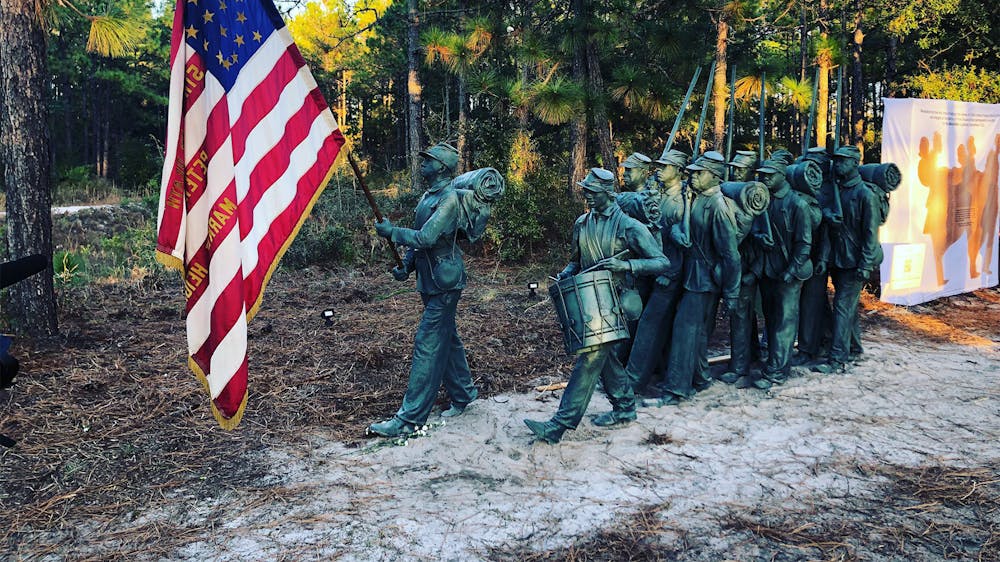Over 120 years ago, a group of white supremacists performed a coup targeting the biracial government of Wilmington, N.C., destroying Black property and taking an indeterminate number of lives. Today, Stephen L. Hayes’s statue depicting soldiers from the United States Colored Troops (USCT) stands proudly in the same city.
In conversation with historian William Sturkey, Hayes reflected on the importance of this monument. Titled “Boundless," this piece is located on the same earth that the USCT marched on during the Civil War. A few sculptures are cut in half, with the silhouettes holding the names of USCT members.
The sculptures themselves were created using casts of descendants of the soldiers and USCT reenactors. To Hayes, allowing them to walk in the footsteps of their ancestors was a central focus of his work. He pointed out how these statues are not placed on pedestals, but rather eye-to-eye with the observers, further adding to the idea of them being real humans marching into battle, with generations of legacy left behind.
Sturkey asked Hayes about what "Boundless" meant to him in an era where the destruction of Confederate statues has become a central debate.
“What would the conversation be if the negative statue was kept up? What would these two statues be saying to each other?” Hayes mused. “What is the conversation that these two statues are having with the audience, with the viewers?”
With "Boundless," Hayes also hoped to create a positive narrative around Black history due to many preexisting art pieces surrounding race depicting negative histories; his aim is to bring the true, hidden history to the front. He views works such as "Boundless" not as his, but the people’s.
Hayes and Sturkey covered other pieces of Hayes’ extensive portfolio, placing special focus on “Voices of Future Past,” a set of statues sculpted by Hayes that was on display at the National Cathedral in Washington. Focusing on Black masculinity, the sculptures seek to encourage Black men to express their feelings and use their voices during emotional and traumatic events, especially when they are young boys. This was inspired by an event in Hayes’s life where he was falsely accused of sexual assault as a young boy, with him unable to tell his mother until decades later.
Another central theme of many of Hayes’s works is capitalism. “Cash Crop” depicts the slave trade and its relation to capitalism and consumerism in America. Hayes created fifteen life-size statues, with each one representing one million slaves brought to America. Each statue is physically chained to a pallet. Hayes related it to modern-day sweatshops. Past and present, he explained, the demands of capitalism can place people in chains.
As Sturkey pointed out, there are three distinct motifs noticeable throughout Hayes’ history-focused art: a pawn, an ear of corn and a horse. The pawn represents people’s susceptibility to becoming figurative pawns in a capitalistic society, with corporations being able to easily manipulate their target populations from a young age. The ear of corn is a result of genetic modification, representing how outside forces can manipulate someone’s outcome. For Hayes’s art, this is usually in the form of slave ships taking Africans from their native lands and bringing them to America, forever altering these populations. The horse comes from a slavery-era letter comparing slaves to horses, with both needing to be “broken in” and serving a purpose for their master.
The former symbol can currently be seen at the Nasher Museum of Art at Duke. A part of the series “Reckoning and Resilience: North Carolina Art Now,” Hayes’ piece “Flying ‘W’” depicts a many-legged, blindfolded horse performing the flying W trick. Floating hands hold onto the creature by a rope, with the positioning of the hands reminiscent of the hold used for rifles. This is representative of his view of the Black body being historically used as a disposable tool, similar to that of a horse. If just one leg breaks, for either the horse or the person, they are rendered useless in their master’s eye.
This conversation was organized by Duke’s Perkins Library. It was second in the series “Standing on the Side of Freedom: Slavery and Emancipation in the United States.” The exhibit that accompanies this series, “To Stand By the Side of Freedom,” can be viewed in Perkins or online.
Get The Chronicle straight to your inbox
Signup for our weekly newsletter. Cancel at any time.

